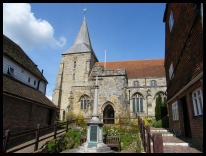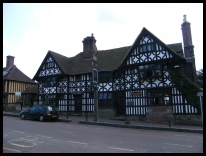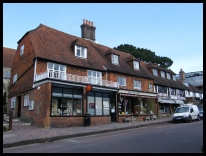|
| |
 Mayfield in East Sussex is a large village in north-east Sussex, 9
miles south of Tunbridge Wells off the A267.
It has a beautiful high street with raised red brick
pavements. The village sign shows the figure of a
young woman and children in a flower covered meadow,
illustrating the Saxon origin of the village name,
Maghefeld, or Maid's Field. Mayfield in East Sussex is a large village in north-east Sussex, 9
miles south of Tunbridge Wells off the A267.
It has a beautiful high street with raised red brick
pavements. The village sign shows the figure of a
young woman and children in a flower covered meadow,
illustrating the Saxon origin of the village name,
Maghefeld, or Maid's Field.
Mayfield is famous for the legend of St Dunstan. The
saint, formerly a blacksmith was working at his forge
when the Devil paid him a visit, disguised as a beautiful
woman, with a view to leading him astray. However St
Dunstan spotted the cloven hooves beneath the dress,
and grabbed the devil's nose with his red hot pincers!
thus foiling Satan's evil intentions.
According to another legend, Satan returned again as a
weary traveller in need of a horseshoe, Dunstan saw
through the disguise once again and beat the Devil
until he pleaded for mercy, and swore never to enter
any house with a horseshoe above the door.
Not surprisingly the church is dedicated to St Dunstan.
It is set back from the main street, and was largely
rebuilt after a fire destroyed it, along with most of
the village , in 1389. It was damaged again in 1621
when it was struck by lightning. The importance of the
iron industry in the area is seen again inside the church,
where 2 cast iron tomb slabs are set in the floor of
the nave.
Dunstan became Archbishop of Canterbury from 960 - 988,
and is credited with founding Mayfield Palace near the
church. It was one of the great residences of the
medieval Archbishops of Canterbury. It ceased to be an
ecclesiastical residence and was sold off in 1567.
It was bought by Sir Thomas Gresham, founder of the
Royal Exchange, and he entertained Elizabeth 1st there.
In 1864 it was purchased by the Dowager Duchess of Leeds
and presented to The Sisters of the Holy Child Jesus.
It was converted into a Roman Catholic boarding school,
and remains so to this day. Visitors to the convent
may see the famous tongs of St Dunstan, and his anvil.
Like many places in the area, Mayfield prospered at the
height of the iron industry, and much of its finest
architecture dates from that time. 'Middle House', in
the High Street is a splendid oak beamed Tudor Inn.
The date 1575 is carved into the barge boards. Eighteen
years before the inn was built during the reign of
Queen Mary , four Protestants were condemned here and
burned at the stake in Lewes . The martyrs were not
forgotten by the community, which has a thriving
Bonfire society. In fact Mayfield's Bonfire Boys and
Belles, are one of the oldest Bonfire organisations
in the country.
1710's brought major smuggling into the area with the
Mayfield Gang and their leader Gabriel Tomkins, a
bricklayer from Tunbrige Wells, bringing relatively
non violent owling (Wool smuggling). The gang consisted of local farmers
and others , who smuggled their own wool abroad, and brought in brandy
and silks by return. They usually made well organised trips to the coast
with 20 - 30 armed men.
They were not cruel, and usually tied up people who crossed them, but
released them later, rather than killing them as per the later
Hawkhurst Gang and Groombridge Gang . In 1721 Gabriel was chased from
Burwash to Nutley and arrested , the gang without its leader broke up.
The Mayfield Gang had wide support from the local population as they
only used violence if it was used against them, and the profits they
made went into the local community.
The area was affected by the Swing riots in the autumn of 1830 with the
land workers demanding reasonable wages, these were put down forceably
by army on 15th November. A number of local workers were imprisoned or
transported to the colonies.
Nearby Argos Hill features an unusual post mill. It has been a feature
of the area since 1834. Restored now, it was almost demolished during
the First World War when it was considered too good a landmark for
German Zepplins!
In September 1880, the steam train line was built from Eridge to Hailsham ,
stopping in Mayfield . The single line track became known as the
Cuckoo Line after the Cuckoo Fair held at nearby Heathfield .
This village is associated with the Sussex Bonfire Societies , who provide
noisy processions, unbelievable outfits and fantastic firework displays throughout
the month of November - a spectacle not to be missed. |
|
 The High Street in Mayfield in East Sussex is a beautiful example
of the East Sussex Iron wealth, with many Black and
White houses. The High Street in Mayfield in East Sussex is a beautiful example
of the East Sussex Iron wealth, with many Black and
White houses.
It is well worth walking up and down the High Street
and examining the buildings.
At the top of the hill looking towards Wadhurst is
a very nice view north west. |
|
 Mayfield in East Sussex is quite a large village, and has a nice
range of shops. Mayfield in East Sussex is quite a large village, and has a nice
range of shops.
The nearest small shopping centre is Heathfield
about 4 miles to the south, with the nearest large
town Tunbridge Wells about 8 miles north.
The Heathfield to Tunbridge Wells bus service passes
through the village.
The nearest trains are at Wadhurst about 5 miles
north east, providing a 1 hour journey to London,
with a service every 30 minutes. |
|
| Mayfield is shown as the red symbol on the map. |
|
|
Nearby Villages
(click on symbol to see the village page) |
| Village= | |
Town= | |
Recorded in Domesday= |  |
| |
|
|
Brightling |
(famous for Mad Jack Fuller) | | 7.16 miles |
|
|
Broad Oak |
(Smallpox at the Academy) | | 3.17 miles |
|
|
Burwash |
(The home of Rudyard Kipling) | | 5.71 miles |
|
|
Burwash Common |
(Roughest pub in the South East) | | 4.28 miles |
|
|
Burwash Weald |
(Roughest pub in the South East) | | 4.61 miles |
|
|
Buxted |
(The first Iron Cannon in England) | | 6.09 miles |
|
|
Cade Street |
(Jack Cade and the Kentish rebellion) | | 3.87 miles |
|
|
Cross in Hand |
(The Crusaders Assembly) | | 3.69 miles |
|
|
Crowborough |
(The home of Sir Arthur Conan Doyle) | | 5.06 miles |
|
|
Five Ashes |
(Vast collection of rock plants) | | 2.23 miles |
|
|
Framfield |
(380 years without a church tower) | | 7.05 miles |
|
|
Hadlow Down |
(Wealden Cannons and Charcoal) | | 3.84 miles |
|
|
Heathfield |
(19th Century Natural Gas) | | 3.76 miles |
|
|
Mark Cross |
(Policeman arrests eccentric landowner) | | 2.80 miles |
|
|
Rotherfield |
(Source of the rivers Rother and Uck) | | 2.58 miles |
|
|
Stonegate |
(Ancient Roman Cross Road) | | 5.09 miles |
|
|
Ticehurst |
(Anne Boleyn and Pashley Manor) | | 6.65 miles |
|
|
Wadhurst |
(Last bare fisted Prize-Fight in England) | | 4.37 miles |
|
|